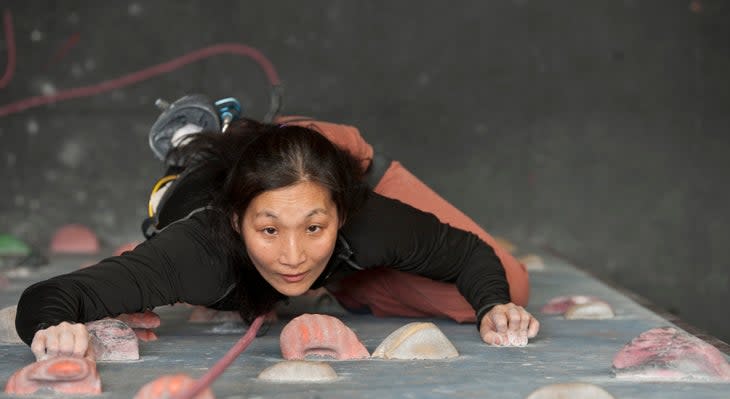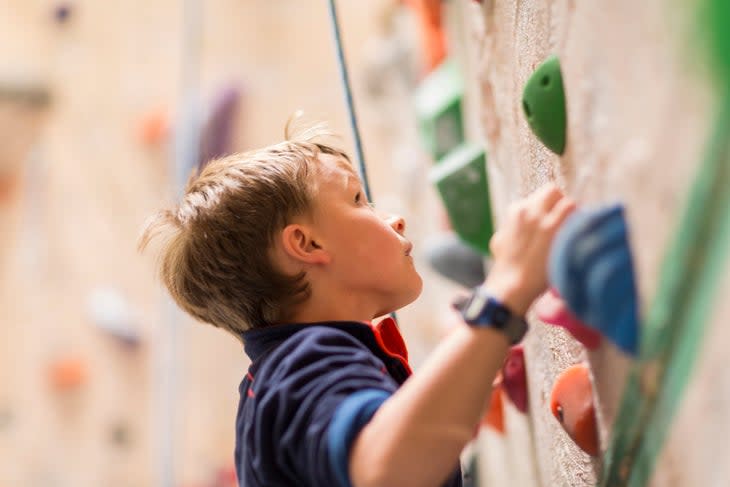First Time Indoor Climbing? Here’s What You Need to Know
This article originally appeared on Climbing
Did you know you're a great ape?
Recasting that, humans are members of the same zoological family (the Hominidae, or great apes) as gorillas, chimpanzees, and orangutans. We all evolved from a common ancestor. Given our cousins, it feels not a great stretch to say we have the genes to cling, climb, and hang. Anyone can do it--and it's not as strength-dependent as you think.
Climbing is as much technique-reliant as it is on physical ability. You don't need to be able to do a pull-up to climb. Skill and strategy are paramount, and the best way to learn the basics for climbing is via an indoor rock climbing gym.
Here's your guide to getting started.
This article is free. Please support us with a membership and you'll receive Climbing in print, plus our annual special edition of Ascent and unlimited online access to thousands of ad-free stories.
1. The equipment
On your first trip to the gym, wear comfortable workout attire. Be sure to bring water and snacks. At the gym, you'll want to rent climbing shoes and chalk. If you plan on getting on a rope (more on that below), you'll also need to rent a harness.
[Also Read: How to Find and Fit Your Next Climbing Shoe]
2. Understanding the space
Climbing gyms vary, but most will have what's known as a bouldering area and a rope section, the latter of which may be further divided into top rope and lead climbing areas. Bouldering involves climbing freely on a wall (no harness needed!) that is 10 to 15 feet tall. Pads beneath the wall cushion your fall. Top roping and lead climbing both involve climbing on taller walls--typically 30 to 60 feet tall--while attached to a rope for safety.
[Also Read: Rookie Mistakes: Seven Things Beginner Climbers Get Wrong]
[Also Read: Sure, it keeps our hands dry. But why did climbers start using chalk?]
3. Falling while bouldering
On your first trip to the gym, try a few practice falls in the bouldering area before venturing too high. Start at a low point on the wall, let go and try to roll on your back as soon as you hit the ground. Never put your arms out to catch yourself. You'll want to hit the ground in a squat position, so that your knees bend as you impact. Progressively take falls from higher up on the wall until you feel confident and in control. Keep in mind that falling is scary, and it will likely take some getting used to.
[Also Read: Overcome Your Fear of Falling: Part 1--Intro and History]

4. Rope climbing tips
To rope climb, you will need a partner to belay you. Belaying is the technique used to arrest a falling climber. As a belayer, your job is to ensure your partner is caught by the climbing rope. You will learn how to belay in your gym orientation, along with a few commands to use with your partner to ensure you're both on the same page.
[Also Read: Don't Drop Your Partner, and Other Ways to Not Screw Up on Belay]
5. "Climbing is inherently dangerous."
Chances are high you'll hear that exact phrase in your orientation tour, and for good reason. Whether you try bouldering or choose to climb on a rope, simple mistakes can lead to serious consequences. Accidents occur due to complacency.
[Also Read: Safety First: Avoiding Climbing Accidents In The Gym]
6. The Holds (the things on the walls that you grab)
Jug: Holds with a deep concavity and large rim to wrap your fingers around. Think of the handle of a gallon jug.
Crimp: A hold that has a thin edge to latch onto, such as the top of a doorframe.
Sloper: A sloper has no clear edge. You typically grip it with all five fingers, like you would palm a basketball.
Pinch: As the name suggests, a pinch is a hold that you can wrap your thumb around so that you pinch it. Pinches may be skinny or wide, like a 2-by-4 piece of wood.
7. Where to start
Regardless of whether you're bouldering or rope climbing, you can simply pull on the wall and grab whichever holds you want. But if you want a challenge, you can follow the marked "problems" (for bouldering) or "routes" (for rope climbing). Your gym will have a system for marking a path up the wall and rating how hard that path is. Most likely, your gym will distinguish different problems and routes with colored holds. If this is the case, for example, you might choose to only use pink holds to complete the problem or route. Some gyms, rather than colored holds, mark the path with tape.

8. Understanding Grades
Boulder problems range from V0-V17, while routes go from 5.6 to 5.15d, with V0 and 5.6 being the easiest for each style of climbing. You'll want to start here. You can also ask the gym staff for suggestions.
9. How to progress
The best way to get better at climbing is by climbing. Simply by putting the time in, you will progress. It also helps to take a class, watch other more experienced climbers, and ask a friend. No matter how good you get, climbers always turn to others for advice.
[Also read: Climbing Terms and Definitions]
10. Some etiquette to keep in mind
Always be aware of your surroundings. Before getting on the wall, make sure you're not too close to someone else; give others space so that there is zero risk of someone falling atop each other. Also, if the gym is busy, remember not to hog a wall by trying a problem over and over again. It's important to take turns. Lastly, for sanitary reasons, take your climbing shoes off before entering the bathroom.
For exclusive access to all of our fitness, gear, adventure, and travel stories, plus discounts on trips, events, and gear, sign up for Outside+ today.

